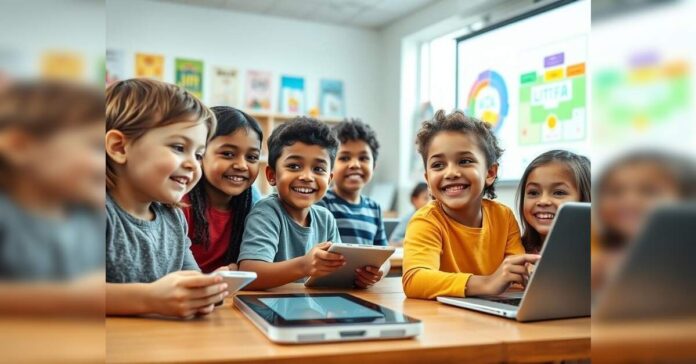By Sumanta Kar. Children’s Day is not only a celebration of childhood but also a moment of reflection; a reminder of our collective responsibility to build a future where every child, irrespective of their background, has equal access to opportunities. In today’s rapidly evolving world, digital literacy has emerged as one of the most critical enablers of inclusion and empowerment. It is no longer a ‘good-to-have’ skill; it is a lifeline that determines whether a child can learn, grow, and participate in the economy of tomorrow. As an extension of this thought, digital literacy is no more a luxury but a necessity that would enable children and young people in their journey towards self-reliance and the larger goal of ‘Vikasit Bharat’. India’s education landscape has undergone a transformation in the last decade, with technology playing a pivotal role in expanding access to learning. Yet, the digital divide continues to mirror, and in some cases, widen existing socio-economic inequalities. According to various studies, while urban and affluent children have seamlessly integrated digital tools into their education, millions in rural and marginalized communities still struggle with limited access to devices, unreliable connectivity, and a lack of digital skills. For these children, the gap is not just about technology; it is about opportunity.Digital Literacy as the Great EqualizerDigital literacy, at its core, is the ability to use technology safely, effectively, and creatively. It is not limited to operating a device or browsing the internet. It extends to critical thinking, problem-solving, and responsible digital citizenship. When introduced early and nurtured consistently, digital literacy can level the playing field for children from disadvantaged backgrounds.For instance, when a child in a small village learns to access online educational content, participate in a virtual classroom, or explore new ideas through e-learning platforms, they gain exposure to the same knowledge ecosystem as their urban peers. This access can ignite aspirations, encourage self-learning, and open pathways to higher education and employability.However, for digital literacy to truly act as an equalizer, we must move beyond the distribution of devices or connectivity solutions. The real challenge lies in creating an ecosystem that combines access, affordability, and adaptability. This includes localized content in regional languages, teacher training in digital pedagogy, and community sensitization on the responsible use of technology.Bridging the Gap: Building Access, Skills, and AwarenessBridging the digital divide requires a multi-dimensional approach that goes beyond infrastructure. True inclusion lies in ensuring that every child has access to devices and connectivity, the skills to use them effectively, and the guidance to navigate the digital world responsibly. Schools, communities, and families all play a critical role in this ecosystem. While policymakers focus on expanding digital infrastructure and integrating technology into curricula, equal attention must be given to teacher training, local language content, and child-friendly learning platforms. Communities can further strengthen this effort by creating shared learning spaces and encouraging digital participation for both children and parents. The private sector, too, has an important role in driving innovation and affordability; from low-cost devices and adaptive learning tools to targeted skilling initiatives that prepare young people for a digital economy. The ultimate goal must be to create an environment where technology becomes a bridge to opportunity, not a barrier that reinforces inequality. Building a Future-Ready GenerationAs India aims to become a $5 trillion economy and a global technology hub, the future workforce will be defined by its digital competence. Yet, the foundation of that workforce is being built today, in classrooms and communities across the country. Ensuring that every child, especially the most vulnerable, acquires digital literacy is essential to building a truly equitable society.We must therefore view digital inclusion as a social investment, not a charitable act. It requires collaboration between government, corporates, and civil society. Public-private partnerships can play a crucial role in strengthening digital infrastructure in rural areas, developing affordable devices, and scaling digital skilling programmes. Corporate CSR initiatives, particularly in the education and technology sectors, can help bridge the last-mile gap by integrating digital literacy into school curriculums and community programmes.Furthermore, policymakers must focus on ensuring that digital learning is safe. As children spend more time online, issues of cyber safety, data privacy, and exposure to harmful content become increasingly relevant. Digital literacy must therefore go hand in hand with digital responsibility, teaching children how to navigate the online world ethically and securely.Conclusion: Empowering Every Child for the Digital FutureThe true measure of progress is not how many have access to technology, but how many can use it to transform their lives. When a child from a marginalized background can access quality education through digital means, when a young person can find employment through online skilling, or when a mother can use technology to support her child’s learning, that is when digital literacy achieves its true purpose.On this Children’s Day, let us reaffirm our commitment to building a digitally inclusive India, one where every child, regardless of their circumstances, has the tools and knowledge to thrive in a technology-driven world. By empowering children with digital literacy today, we are not just closing the education and opportunity gap. We are opening doors to a brighter, more equitable tomorrow!The author Sumanta Karis CEO of SOS Children’s Villages India.DISCLAIMER: The views expressed are solely of the author and ETEDUCATION does not necessarily subscribe to it. ETEDUCATION will not be responsible for any damage caused to any person or organisation directly or indirectly.
Published On Nov 14, 2025 at 12:53 PM IST
Join the community of 2M+ industry professionals.
Subscribe to Newsletter to get latest insights & analysis in your inbox.
All about ETEducation industry right on your smartphone!

